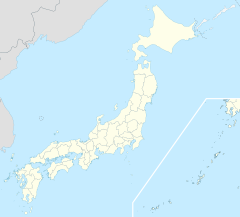Ise Grand Shrine
The Ise Grand Shrine (伊勢神宮, Ise Jingū) is a religious site in Ise, Japan. It is for the sun goddess Amaterasu. The shrine is made up of many smaller shrines, with two main shrines called Naikū (内宮) and Gekū (外宮). People simply call it Jingū (神宮).
| Ise Grand Shrine | |
|---|---|
伊勢神宮 (Ise Jingū) | |
 | |
| Religion | |
| Affiliation | Shinto |
| Deity | Amaterasu |
| Location | |
| Location | Ise, Mie Prefecture, Japan |
| Geographic coordinates | 34°27′18″N 136°43′33″E / 34.45500°N 136.72583°E |
| Architecture | |
| Date established | 4 BCE |
The Naikū Shrine (officially called "Kōtai Jingū") is in Uji-tachi, near Ise. It is where people worship Amaterasu, the sun goddess, who they believe lives there. The buildings are made of wood from a tree called cypress and they don't use nails to put them together. Instead, they use a special way of joining the wood. The Gekū Shrine (officially called "Toyouke Daijingū") is about 6 kilometers from Naikū. It's for Toyouke-Ōmikami, the god of farming, getting food from crops, and work.[1] Besides the Naikū and Gekū shrines, there are 123 more Shinto shrines in and around Ise City. 91 of them are connected to Naikū and 32 are connected to Gekū.[2]
People say the Sacred Mirror Yata no Kagami is kept at this shrine. It is one of the most important and holiest places in the Shinto religion.[3]You can only see the central buildings from the outside, because they're behind four tall wooden fences. Visitors can walk around in the forest and see the old walkways from the Meiji period.
A long time ago, about one out of every ten Japanese people would make a special trip to the shrine. This was very popular and happened a lot, both for religious and business reasons. According to old records, in 1625 over 3.62 million people visited the shrine in 50 days. And in 1829, during a big festival that happens every 20 years, 1.18 million people came to the shrine in just three days.[4]People consider the shrine a sacred place, so they don't check for security. It's considered disrespectful to the shrine. There's a path that people take on their pilgrimage between the two main shrines, and it goes through a neighborhood called Furuichi.
The person in charge of the shrine must be from the Japanese royal family. They make sure the shrine is taken care of. Right now, the person in charge is Princess Sayako Kuroda, who is the daughter of Emperor Emeritus Akihito.[5]
References
change- ↑ Ise Jingu official homepage, "Isejingu". Archived from the original on 2012-05-30. Retrieved 2012-05-30.
- ↑ Ise Jingu official homepage Archived 2012-05-30 at Archive.today
- ↑ Ellwood, Robert S. (1985). Japanese Religion: A Cultural Perspective. Prentice-Hall. ISBN 9780135092828. Retrieved 18 April 2019.
- ↑ お伊勢さま、一度は行きたい庶民の夢 Cleanup Corporation
- ↑ "Emperor's daughter becomes supreme priestess at Ise Shrine". Japan Times. June 21, 2017. Archived from the original on November 8, 2021. Retrieved June 22, 2017.
Sayako Kuroda, the daughter of Emperor Akihito and Empress Michiko, assumed the post of supreme priestess at Ise Shrine this week, the ancient Shinto shrine said.

